Druck DPI 610, DPI 615 IS Operating Manual
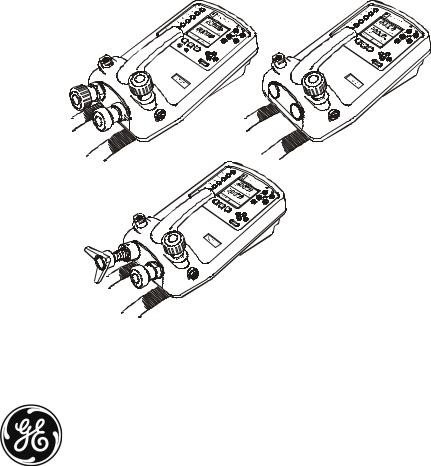
GE
Sensing & Inspection Technologies
Druck DPI 610/615 IS
Intrinsically Safe Portable Pressure Calibrator User manual - K0430
English
To select the manual in an available language go to: //www.gesensing.com/toolsupport/manuals.htm
Français
Pour choisir le manuel dans une langue disponible, accédez à : //www.gesensing.com/toolsupport/manuals.htm
Deutsch
Um das Handbuch in einer vorhandenen Sprache auszuwählen, gehen Sie zu: //www.gesensing.com/toolsupport/manuals.htm
Italiano
Per scaricare il manuale in una delle lingue disponibili consultare la pagina: //www.gesensing.com/toolsupport/manuals.htm
Español
Para seleccionar el manual en uno de los idiomas disponibles vaya a: //www.gesensing.com/toolsupport/manuals.htm
Português
Para selecionar o manual em uma língua disponível vá para: //www.gesensing.com/toolsupport/manuals.htm

WARNING
Before operating this intrinsically safe instrument, read the safety instructions and the special conditions stated on the ATEX certificate (Appendix 2)
Safety
The manufacturer has designed this equipment to be safe when operated using the procedures detailed in this manual. Do not use this equipment for any other purpose than that stated.
This publication contains operating and safety instructions that must be followed to ensure safe operation and to maintain the equipment in a safe condition. The safety instructions are either warnings or cautions issued to protect the user and the equipment from injury or damage.
Use suitably qualified * technicians and good engineering practice for all procedures in this publication.
Pressure
Do not apply pressures greater than the safe working pressure to this equipment.
Maintenance
The equipment must be maintained using the procedures in this publication. Further manufacturer’s procedures should be carried out by authorized service agents or the manufacturer’s service departments.
www.gesensinginspection.com
For technical advice contact the manufacturer.
*A qualified technician must have the necessary technical knowledge,
documentation, special test equipment and tools to carry out the required work on this equipment.
Symbols
This equipment meets the requirements of all relevant European safety directives. The equipment carries the CE mark.
This symbol, on the instrument, indicates that the user should refer to the user manual. This symbol, in this manual, indicates a hazardous operation.
This symbol, on the instrument, indicates do not throw-away in domestic bin, hazardous material, dispose correctly in accordance with local regulations.
i |
K0430 Issue No. 2 |
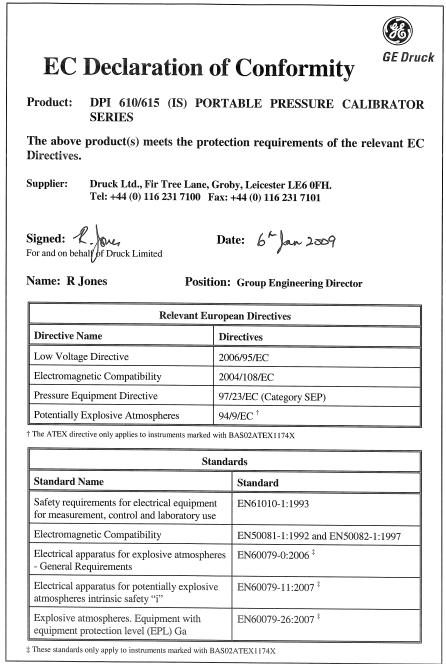
K0430 Issue No. 2 |
ii |

ATEX Approved Models Introduction
These instructions detail the requirements for using the DPI 610 IS and DPI 615 IS intrinsically safe pressure calibrator in a hazardous area. Read the whole publication before starting.
Markings
II 1 G.................................................................... |
Equipment group & category |
Ex ia IIC T4 Ga.................................................................. |
Hazardous location markings |
BAS02ATEX1174X ................................................................................ |
Certificate number |
1180.................................................................................................................................. |
CE Mark |
DPI 61X IS ...................................................................................... |
Specific apparatus type |
(Pressure Range in mbar or psi ........................................ |
Full-scale pressure rating |
Druck LTD. Groby LE6 OFH, UK .................... |
Manufacturer's name and address |
SN *******/YY-MM.................................. |
Serial number and date of manufacture, |
|
Year-Month. |
Requirements and Conditions
Batteries
WARNING: Only replace batteries in a safe area.
•Power supply use only 6 x LR14 (C): Duracell MN1400-LR14, Procell lndustrial MN1400-LR14, Energizer E93.KR14.C.AM2, Energizer Industrial EN93 or Varta 4014 LR14.C.AM2.
Special Conditions for Safe Use
1.The DPI 61X IS Series Pressure Calibrator is not capable of withstanding the 500V r.m.s. electric field strength test between the external connectors and frame of the apparatus as required by Clause 6.4.12 of EN 50020 and this must be taken into account when using the apparatus for input measurements in a system.
2.The outer enclosure may contain light metals in the form of aluminium, magnesium, titanium or zirconium. Therefore, the apparatus must be installed in such a manner as to prevent the possibility of it being subject to impacts or friction. An optional carrying case is case is available for transporting the pressure calibrator to and from the location of use. When the carrying case is used, special condition for safe use item #2 does not apply.
iii |
K0430 Issue No. 2 |
Electrical Parameters
Maximum Output Parameters at the External Measurement Connectors:
lin (SK1) |
Vin (SK2) |
SwitchIn (SK3) |
Uo= 1.1V d.c. |
Uo= 1.1V d.c. |
Uo= 1.1V d.c. |
Io = 0.16 mA d.c. |
Io = 0.11 µA d.c. |
Io = 12 mA d.c. |
Po= 0.15 mW |
Po= 0.03 µW |
Po= 11 mW |
Ci = 0.05 µF |
Ci = 0 |
Ci = 0.05 µF |
Li = 0 |
Li = 0 |
Li = 0 |
lout (SK6) |
RS232 |
External Transducer |
Uo= 7.9V d.c. |
Uo= 7.6V d.c. |
Uo= 7.6V d.c. |
Ci = 0 |
Io = 82 mA d.c. |
Io = 155 mA d.c. |
Li = 0.1 mH |
Po= 162 mW |
Po= 0.43 W |
|
Ci = 0 |
Ci = 0.15 µF |
|
Li = 0 |
Li = 0.9 mH |
|
Um = 250V |
Co = 8.6 µF |
|
|
Lo = 0.3 mH |
The output parameters at sockets SK1, SK2 and SK3 do not exceed the values specified in Clause 5.4, Simple Apparatus, of EN 50020.
Maximum Safe Input Parameters: Sockets SK1, SK2, SK3 and SK6
Ui= 30V li= 100 mA
Pi = 1.0W
Installation
WARNING: Do not use tools on the pressure calibrator that might cause incendive sparks - this can cause an explosion.
•Provide additional protection for equipment that may be damaged in service.
•Installation should be carried out by qualified plant installation technicians in compliance with the latest issue of EN 60079-14.
Declaration Requirements
The DPI 610 IS and DPI 615 IS pressure calibrators are designed and manufactured to meet the essential health and safety requirements not covered by the EC Type Examination Certificate BAS02ATEX1174X when installed as detailed above. The intrinsically safe pressure calibrators are designed and manufactured to protect against other hazards as defined in paragraph 1.2.7 of Annex 11 of the ATEX Directive 94/9/EC.
K0430 Issue No. 2 |
iv |
|
Specification |
Safe working pressure |
|
20 bar range (300 psi) |
1.75 x full-scale |
350 bar range (5000 psi) |
1.2 x full-scale |
400 bar range (6000 psi) |
1.5 x full-scale |
All other ranges |
2 x full-scale |
Accuracy
Combined non-linearity, hysteresis and repeatability
±70 mbar range |
(2 inHg) |
0.05% F.S. |
up to ±150 mbar |
(4.4 inHg) |
0.05% span |
200 mbar to 20 bar (3 psi to 300 psi) [Calibrator]): |
0.025% F.S. |
|
35 bar to 700 bar (500 psi to 10000 psi) [Indicator] |
0.025% F.S. |
|
70 bar to 400 bar (1000 psi to 6000 psi) [Hydraulic] |
0.025% F.S. |
|
Pressure Ranges
Refer to the pressure range matrix in the data sheet.
Temperature Effects
±0.004% of reading/°C (averaged over -10° to +40°C w.r.t. 20°C) ±0.002% of reading/°F (averaged over +14° to 104°F w.r.t. 68°F)
Power supply |
|
|
Batteries |
6 x 1.5 V C cells, alkaline (up to 60 hours nominal use at 20°C) |
|
Voltage Inputs |
|
|
Range: |
|
±30V |
Accuracy |
|
±0.05% rdg, ±0.004% F.S. |
Resolution |
|
100µV max |
Current Inputs |
|
|
Range: |
|
±55mA |
Accuracy |
|
±0.05% rdg, ±0.004% F.S. |
Resolution |
|
1µA max |
Current sink |
|
|
Range: |
|
24mA |
Accuracy |
|
±0.05% rdg, ±0.01% F.S. |
Resolution |
|
1µA max |
Display |
|
|
Size: |
|
60 x 60 mm (2.36” x 2.36”) LCD Graphics |
Reading |
|
±99999, update rate 2 readings/sec |
Environment |
|
|
Operating Temperature: |
-10°C to 50°C (+14°F to 122°F) |
|
Calibrated Temperature: |
-10°C to 40°C (+14°F to 104°F) |
|
Storage Temperature: |
-20°C to 60°C (-4°F to 140°F) |
|
Calibration Temperature: |
21°C ±2°C (70°F ±4°F) |
|
Sealing |
|
Sealed to IP54 (NEMA 4) |
Physical |
|
|
|
|
|
Size: |
|
300 x 170 x 140 mm (11.8” x 6.7” x 5.5”) |
Weight: |
|
3 kg (6.6lb) |
v |
K0430 Issue No. 2 |
Introduction |
|
General |
|
Description of Procedures |
1 |
Summary of Functions |
|
Using this Guide |
2 |
OPERATOR CONTROLS |
3 |
DISPLAY |
3 |
HARD KEY FUNCTIONS |
4 |
SOFT KEYS |
5 |
CURSOR KEYS |
5 |
ELECTRICAL CONNECTIONS |
6 |
Getting Started |
|
Fitting Batteries |
7 |
Switching On |
7 |
Change Pressure Units |
8 |
Voltage and Current Measurement |
8 |
Typical Calibration Set-up (Pressure to Voltage) |
9 |
Zero Display Reading |
9 |
Task Selection |
|
Task Key |
10 |
Using Task Functions |
10 |
Set Units |
10 |
Cal Mode (DPI 615 instruments only) |
11 |
Basic Mode (Task BASIC) |
11 |
Taking Measurements |
|
Pressure Transmitter (P-I) Task |
12 |
Voltage Output Pressure Transmitter (P-V) Task |
12 |
Pressure Converter (P-P) Task |
13 |
Current to Pressure Converter (I-P) Task |
14 |
Pressure Switch Test (P-Switch) Task |
14 |
Pressure to Display (P-Display) Task |
15 |
Leak Test (Leak Test) Task |
16 |
Transmitter Simulator (TX SIM) Task |
17 |
Relief Valve Test (REL VALVE) Task |
18 |
K0430 Issue No. 2 |
vi |
Advanced Task |
|
General |
19 |
Select Input |
19 |
Ambient Temperature Measurement |
19 |
Process Functions |
20 |
Tare Process Function |
21 |
Min/Max Process Function |
22 |
Filter Process Function |
22 |
Flow Function |
23 |
% Span |
23 |
Select Output |
24 |
Electrical Outputs (Loop Power) |
24 |
mA Step |
25 |
mA Ramp |
26 |
mA Value |
27 |
Define New Task |
28 |
Clear Task |
28 |
Memory Operations |
|
Saving Display or Data Log |
29 |
Store Operations (Screen Snapshots) |
29 |
Recalling Stored Data (Screen Snapshots) |
29 |
Datalog Operations |
30 |
Auto Log (Timer) |
30 |
Manual Logging |
30 |
Recall Data Log Files |
31 |
Uploading Data Log Files |
32 |
Delete Data Log and Procedure Files |
32 |
Downloading Procedure Files (DPI 615 instruments only) |
33 |
Running Procedure Files (DPI 615 instruments only) |
34 |
Recalling Data Files (DPI 615 instruments only) |
35 |
Using Set-up |
|
General |
36 |
Store Mode |
36 |
Contrast |
36 |
Settings - Select Set-up Option |
37 |
Units |
37 |
Define Special Units |
37 |
Language |
38 |
RS232 |
38 |
Powerdown |
39 |
Calibration |
39 |
vii |
K0430 Issue No. 2 |
Date and Time (Real Time Clock) |
40 |
Date Format |
40 |
Set Date |
40 |
Set Time |
40 |
Calibration |
|
General |
41 |
Calibration Check |
41 |
Calibration Adjustment |
41 |
Guide to Calibration Procedures |
41 |
Test Equipment |
42 |
Using the Calibration Menu |
43 |
Change PIN |
43 |
Calibrate Internal Ranges |
43 |
Internal Pressure Range |
44 |
Voltage Input Range (5 Volts) |
45 |
Voltage Input Range (30 Volts) |
47 |
Current Input Range (55 mA) |
49 |
Current Output Range (24 mA) |
51 |
Ambient Temperature Channel |
54 |
Calibrate External Sensors |
55 |
Add External Sensor |
56 |
Hydraulic Calibrator Versions |
|
Introduction |
59 |
Safety Instructions |
60 |
Preparation for Use |
60 |
Bleeding the System |
61 |
Operation |
62 |
Draining the Hydraulic Fluid |
62 |
Flushing, Replenishing or Changing the Hydraulic Fluid |
63 |
Appendix 1 - Datalog File Example |
|
Typical Uploaded Datalog File (DPI 610) |
67 |
Typical Uploaded Procedure Data File (DPI 615) |
68 |
Appendix 2 - ATEX Certificate of Conformity |
|
K0430 Issue No. 2 |
viii |
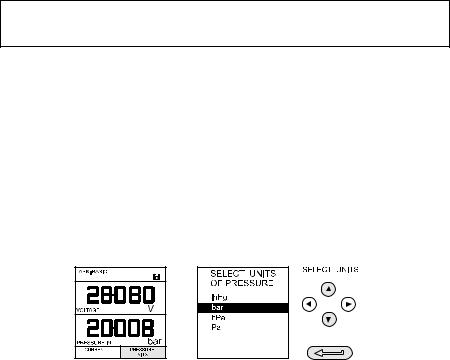
INTRODUCTION |
Summary of Functions |
General
The DPI 610 IS and DPI 615 IS intrinsically safe instruments measure and display pneumatic and hydraulic pressure applied to the test port. Pressure measurement can be absolute, gauge and sealed gauge and in ranges from 2.5 mbar to 700 bar (1.0 inH2O
to 10000 psi).
Calibrator versions of this instrument contain pneumatic or hydraulic pressure generation components to produce pneumatic pressure ranges between -1 to 20 bar (- 14.5 psi to 300 psi) and hydraulic pressure ranges up to 400 bar (6000 psi)
Using external electrical connections, the DPI 610 IS and DPI 615 IS intrinsically safe instruments measure ±30 volts d.c. and ±55 mA. An integral sensor provides measurement of ambient temperature. Additional sensors (option B1) connect to an external connector and extend the pressure measurement range and include differential pressure measurement. The DPI 615 instrument has an RS232 connector to enable downloading of test data to a compatible documenting system. Six alkaline C size batteries, IEC Type LR14, power the instrument.
Important Notice
Zinc-carbon and zinc-chloride cells must NOT be used in this instrument. Use only the battery types as shown in the table on page 7.
Description of Procedures
The procedures apply to both the DPI 610 IS and the DPI 615 IS instruments unless otherwise stated. In the procedures in this manual, hard (fixed function) and soft (variable function) key operations are shown in bold type : TASK and F1. These statements mean press the TASK key and press the F1 key. Soft key operations can be assigned to both the F1 and F2 keys. Where a specific soft function is referred to it is written in bold italics (e.g.) PROCESS.
This instrument has a number of operating modes that are described in simplified form in the following sections. Diagrams accompanying the procedures give typical selection sequences and shaded controls indicate that this control key should be pressed in the appropriate sequence. Diagrams should be read from left to right, top to bottom where appropriate. A shaded display soft box indicates that the function key immediately below that soft box should be pressed (either F1 for the left hand soft box or F2 for the right).
In the above diagram the following key sequence is indicated.
(a)Press the F2 key (the key immediately below the UNITS soft box).
(b)Use the Up and Down cursor keys (only) to select the required option. (If all keys shaded, use all these keys to select or enter data).
(c)Press the ENTER key.
1 |
K0430 Issue No. 2 |

INTRODUCTION |
Summary of Functions |
Using This Guide
The following key symbols are used in the procedure diagrams:
Shaded cursor keys indicate that a combination of these four keys, Up, Down, Left and Right should be used to (e.g.) enter an alpha numeric value or to select a function.
Indicates the ENTER key. Used to confirm an operation or a selection. Shading indicates key operation.
Exit key, used to clear current menu selection and return to next menu level above current level. Used as an escape key from current operation. Shading indicates key operation.
Hardkey (total 7). Legend beside key symbol indicates function. Shading indicates key operation.
Maximum Instrument Ratings
The following table shows the maximum measurement input ratings of the instrument which should not be exceeded.
PRESSURE |
120% FULL SCALE |
|
|
VOLTAGE |
30 V d.c. |
|
|
CURRENT |
55 mA d.c. |
|
|
Note 1: The display flashes if the input pressure, voltage or current overrange.
Note 2: Max applied voltage for external loop supply = 30V dc (see page 8).
K0430 Issue No. 2 |
2 |

INTRODUCTION |
Summary of Functions |
OPERATOR CONTROLS (Figure 1 and 2)
These divide into two groups, the operator/display controls (Figure 1) and the pressure/ vacuum generation components (Figure 2). The operator controls and a typical display, common to all instrument versions, is shown below.
1
 DPI 615 IS
DPI 615 IS
max 30V
|
|
|
TASK: BASIC |
|
|
|
|
|
|
|
|
|
2 |
|
|
|
VOLTAGE |
V |
|
|
|
|
|
PRESSURE INT |
bar |
|
|
|
|
|
CURRENT |
PRESSURE |
|
|
|
|
|
|
UNITS |
|
|
|
|
|
|
|
|
3 |
|
|
|
F1 |
F2 |
|
|
|
|
|
|
|
|
4 |
|
|
7 |
6 |
5 |
|
|
|
|
|
|
|
||
1 |
Display |
2 Electrical Measurement Input Sockets |
3 |
Cursor Keys |
||
4 |
Enter Key |
5 Function (soft) Keys |
6 Hard Keys |
7 |
On/Off Key |
|
Figure 1 - DPI 610/615 IS Key-pad
DISPLAY
The display and key-pad of the instrument divides into four distinct sections. The two main sections of the display are used to show an input and an output. The remaining two sections show the status display area and define the soft key functions. A typical display is shown below:
Status display |
|
TASK: BASIC |
|
|
|
|
|
|
|
|
||||||
|
|
|
|
|
|
|
|
|
||||||||
|
|
|
|
|
|
|
|
|
|
- + |
|
|||||
Input display |
|
|
|
|
|
|
|
|
|
|
|
|
|
|
|
|
|
|
|
|
|
|
|
|
|
|
|
|
|
|
|
|
|
|
|
|
|
|
|
|
|
|
|
|
|
|
|
|
|
|
|
|
VOLTAGE |
|
|
|
|
|
V |
||||||||
Output display |
|
|
|
|
|
|
|
|
|
|
|
|
|
|
|
|
|
|
|
|
|
|
|
|
|
|
|
|
|
|
|
|
|
|
|
PRESSURE INT |
|
|
|
|
|
bar |
||||||||
Soft boxes |
|
CURRENT |
|
|
|
PRESSURE |
||||||||||
|
|
|
|
|
|
|
|
|
|
|
UNITS |
|||||
3 |
K0430 Issue No. 2 |

INTRODUCTION |
Summary of Functions |
||
HARD KEY FUNCTIONS (Fig. 1) |
|
|
|
|
|
|
|
Key |
Function |
|
Page |
|
reference |
||
|
|
|
|
|
|
|
|
I/O |
This key selects the instrument ON and OFF. |
|
7 |
|
|
|
|
|
The SETUP key provides access to the instrument’s general |
36 |
|
SETUP* |
configuration parameters that are set-up to certain default |
|
|
|
parameters on delivery. |
|
|
|
|
|
|
|
The ZERO key zeroes either the selected input or output display, only if |
9 |
|
ZERO |
the display reading is within 5% of zero. Attempts to zero a larger |
|
|
|
offset result in an error message, Zero too large. |
|
|
|
|
|
|
INPUT* |
The INPUT key selects the input parameter to be displayed. |
18, 19 |
|
|
|
|
|
|
The TASK key rapidly configures the instrument for a number of |
10 |
|
TASK |
different types of external device calibration. There are twenty task |
|
|
configurations available, eleven pre-programmed configurations and |
|
||
|
|
||
|
nine user defined configurations |
|
|
|
|
|
|
OUTPUT* |
The OUTPUT key selects the output parameter to be displayed. |
24-27 |
|
|
|
|
|
|
Depending upon how the instrument’s STORE mode is set-up, this key |
29, 36 |
|
STORE* |
is used either to store up to 20 display screens (in SNAPSHOT mode), |
|
|
|
or to manually log a screen in DATALOG mode. |
|
|
|
|
|
|
|
This key recalls a previously stored screen to the display. Depending |
28, 31, 35 |
|
|
on the STORE mode set-up, operation of this key recalls either the |
|
|
RECALL* |
snapshot of a previously stored screen or data log file. In STORE |
|
|
mode, selection displays the last screen stored. By using the cursor |
|
||
|
|
||
|
keys, the operator can scroll either forward or back through memory |
|
|
|
locations. |
|
|
|
|
|
|
ENTER |
The ENTER key either enters data (accept entered data), or, in |
2 |
|
|
conjunction with the soft keys, accepts a given selection. |
|
|
|
|
|
|
|
The EXIT key operates in conjunction with all the other hard and soft |
2 |
|
EXIT |
keys to exit from the current screen or menu level, to the level |
|
|
immediately preceding it. To quit completely from any menu level, |
|
||
|
|
||
|
press EXIT until the MEASURE/SOURCE screen is displayed. |
|
|
|
|
|
|
* These key functions are not available in BASIC mode
K0430 Issue No. 2 |
4 |
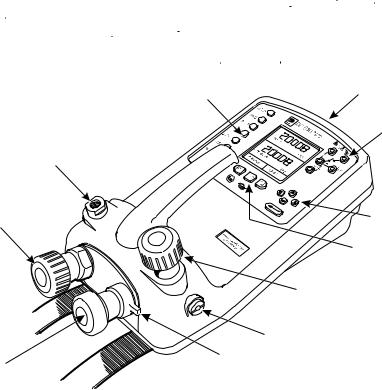
INTRODUCTION |
Summary of Functions |
SOFT KEYS (Fig. 1)
Three soft keys, designated F1, EXIT and F2, are situated immediately below the display as shown below. These keys have their function allocated by the instrument software which is indicated in the bottom of the display (Voltage for F1 and Units for F2 in this example). They are used to select menu (program) options and are fully described under the appropriate section headings.
CURSOR KEYS (Fig. 1)
The cursor keys consist of a block of four keys, designated up  , down
, down  , left
, left  , and right
, and right  . In programs where options need to be selected from a list, (e.g.) the TASK selection program, the up
. In programs where options need to be selected from a list, (e.g.) the TASK selection program, the up  and down
and down  cursor keys are used to highlight one of the options, from which it can be selected by the ENTER key. In TASK mode, where more than one page of options are provided, the left
cursor keys are used to highlight one of the options, from which it can be selected by the ENTER key. In TASK mode, where more than one page of options are provided, the left  , and right
, and right  cursor keys will switch between pages.
cursor keys will switch between pages.
3
2
4
1
5
11
6
7
8
9
10
1 |
Test port, connect to unit under test |
2 |
Hard keys |
3 |
Cover (external interfaces) |
4 |
Electrical inputs |
5 |
Cursor keys |
6 |
Function (soft) keys |
7 |
Release valve (releases pressure through 8) |
8 |
Vent port |
9 |
Select positive or negative pressure |
10 |
Pump |
11 |
Fine pressure adjuster |
|
|
Figure 2 - DPI 610/615 IS Calibrator Controls
5 |
K0430 Issue No. 2 |
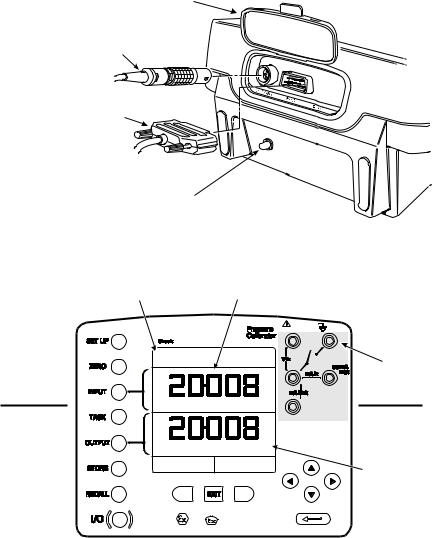
INTRODUCTION |
Summary of Functions |
ELECTRICAL CONNECTIONS
1
|
|
2 |
1 |
Cover, closed when |
|
|
not using connectors |
|
2 |
External transducer |
|
3 |
RS232 connector |
3 |
4 |
Temperature sensor |
|
USE |
RS232 |
|
IN |
|
|
|
SAFE |
|
AREA |
ONLY |
|
4
Figure 3 - Electrical System Connections
Measurement inputs and Source outputs are made via the control panel sockets as shown below:
1 |
2 |
 DPI 615 IS
DPI 615 IS
max 30V CAT II
TASK: BASIC
3
|
INPUTS |
|
|
|
|
VOLTAGE |
|
V |
|
|
OUTPUTS |
|
|
|
|
PRESSURE INT |
bar |
|
|
|
CURRENT |
|
PRESSURE |
|
|
|
|
UNITS |
4 |
|
|
|
|
|
|
F1 |
|
F2 |
|
1 |
Status window 2 Input window |
3 |
Electrical measurement input sockets |
|
4 |
Output window |
|
|
|
Figure 4 - Electrical Measurement Inputs/Source Outputs
K0430 Issue No. 2 |
6 |

Getting Started
Fitting Batteries
|
|
1 |
|
|
|
|||
|
|
|
|
|
|
|
|
|
Manufacturer |
Type No. |
|
|
|
|
|
|
|
|
|
|
|
|
|
|
|
|
Energizer |
Industrial Type EN93 |
|
|
|
|
|
|
|
|
|
|
|
|
|
|
|
|
Energizer |
Type E93.LR14.C.AM2 |
|
|
|
|
|
|
|
|
|
|
|
|
|
|
|
|
Duracell |
Type MN1400-LR14 |
|
|
|
|
|
|
|
|
|
2 |
|
|
|
|
|
|
Varta |
No.4014 Type LR14.C.AM2 |
|
|
|
|
|
|
|
|
|
|
|
|
|
|
||
Procell |
Industrial Type MN1400-LR14 |
|
|
|
|
|
|
|
|
|
|
|
|
|
|
|
|
3 |
|
|
|
|
|
|
|
|
1 |
Cover fixing |
||||
|
|
|
|
|
|
|
|
|
|
|
|
|
|
screws. |
|
|
|
|
|
|
|
|
|
|
|
|
|
|
|
TASK: BASIC |
|
|
|
|
|
|
|
|
2 |
Six alkaline C |
||||
|
|
|
|
|
|
- + |
|
|||||||
|
|
|
|
|
|
|
|
|
|
|
|
|
|
cells, see table. |
|
|
|
|
|
|
|
|
|
|
|
|
|
|
|
|
|
|
|
|
|
|
|
|
|
|
|
|
|
Only use the |
VOLTAGE |
|
|
|
|
|
V |
|
battery type in |
||||||
|
|
|
|
|
|
the table. |
||||||||
|
|
|
|
|
|
|
|
|
|
|
|
|
|
|
|
|
|
|
|
|
|
|
|
|
|
|
|
3 |
Low battery |
|
|
|
|
|
|
|
|
|
|
|
|
|
||
|
|
|
|
|
|
|
|
|
|
bar |
||||
PRESSURE INT |
|
|
|
|
|
|
indication. |
|||||||
CURRENT |
|
|
|
PRESSURE |
|
|
||||||||
|
|
|
|
|
|
|
|
UNITS |
|
|
||||
WARNING: BATTERIES MUST ONLY BE FITTED IN A SAFE AREA. USE ONLY THE BATTERIES SPECIFIED IN THE TABLE.
Caution: Old batteries can leak and cause corrosion. Never leave discharged batteries in the instrument. Old batteries should be treated as hazardous waste and disposed of accordingly.
Switching On
Press the I/O switch on the front panel and proceed as follows:
The first time that the instrument is powered up, it will power-up in BASIC mode with the main screen displaying voltage in the input display area and pressure in the source display area. To switch to Current as input, press F1 as shown. Similarly, F1 to return to
Voltage.
Note: No other keys are active in this mode and the instrument can only be reconfigured by pressing the TASK key and selecting another mode.
7 |
K0430 Issue No. 2 |
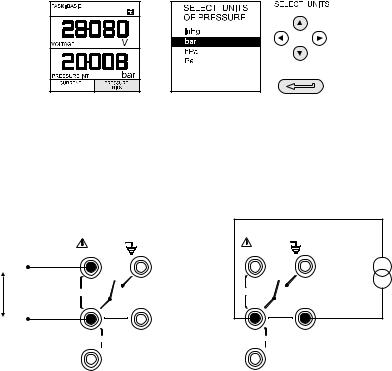
Getting Started
Change Pressure Units
To change the pressure units proceed as follows. If the four units displayed are not the units required, press TASK and select any task, other than BASIC, press SETUP and proceed as detailed on page 36. To return to BASIC mode, press TASK and select BASIC.
In BASIC mode, the unit is configured to carry out basic Pressure to Voltage (P to V) or Pressure to Current (P to I) tests, a typical test procedure follows:
Voltage and Current Measurements
Connect the electrical input sockets as follows for voltage and current measurements. Use the test leads provided and DO NOT push bare wires into the sockets.
|
|
max 30V |
|
|
max 30V |
- |
|
|
|
|
|
|
|
|
+ |
|
|
|
|
|
V |
|
Vin |
|
Vin |
|
+ |
|
|
|
|
|
||
|
|
|
55mA |
|
|
55mA |
|
- |
mA in |
max |
|
mA in |
max |
|
|
|
|
|||
|
|
|
|
|
|
|
|
|
mA Sink |
|
|
mA Sink |
|
Voltage |
Current |
Maximum applied voltage = 30V dc. |
Maximum input current = 55mA dc (at 30 V dc) |
K0430 Issue No. 2 |
8 |
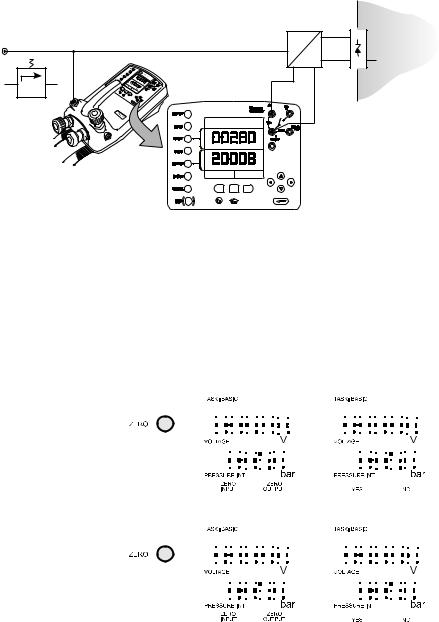
Getting Started
Typical Calibration Set-up (Pressure to Voltage)
Connect a device under test to the instrument as shown below:
C
A |
P |
|
V
+ -
B |
DPI 615 IS |
Max 30V |
|
CAT II |
|||
|
|
||
|
TASK: BASIC |
|
|
|
VOLTAGE |
V |
|
|
PRESSURE INT |
bar |
|
|
CURRENT |
PRESSURE |
|
|
|
UNITS |
|
|
F1 EXIT |
F2 |
|
D
F
+  +
+
E
-
-
D
A - External pressure source (indicator instruments only) B - Pressure regulator C - Pressure/voltage device D - Barrier E - Excitation 10V F - Safe area
•General Procedure
Use the hand-pump to pressurize the system to the required level as indicated on the display. Allow the display to settle and screw the volume adjuster in or out as a fine adjustment to the required pressure. Record the input: Voltage, reading at each applied pressure.
Zero Display Reading
Both the input and output readings can be set to zero by using the ZERO key and if the displayed reading is within 5% of zero. To zero either the INPUT or OUTPUT displays, proceed as follows:
|
|
|
|
|
|
|
|
|
|
|
|
|
|
|
|
|
|
|
|
|
|
|
|
|
|
|
|
|
|
|
|
|
|
|
|
|
|
|
|
|
|
|
|
|
|
|
|
|
|
|
|
|
|
|
|
|
|
|
|
|
|
|
|
|
|
|
|
|
|
|
|
|
|
|
|
|
|
|
|
|
|
|
|
|
|
|
|
|
|
|
|
|
|
|
|
|
|
|
|
|
|
|
|
|
|
|
|
|
|
|
|
|
|
|
|
|
|
|
|
|
|
|
|
|
|
|
|
|
|
|
|
|
|
|
|
|
|
|
|
|
|
|
|
|
|
|
|
|
|
|
|
|
|
|
|
|
|
|
|
|
|
|
|
|
|
|
|
|
|
|
|
|
|
|
|
|
|
|
|
|
|
|
|
|
|
|
|
|
|
|
|
|
|
|
|
|
|
|
|
|
|
|
|
|
|
|
|
|
|
|
|
|
|
|
|
|
|
|
|
|
|
|
|
|
|
|
|
|
|
|
|
|
|
|
|
|
|
|
|
|
|
|
|
|
|
|
|
|
|
|
|
|
|
|
|
|
|
|
|
|
|
|
|
|
|
|
|
|
|
|
|
|
|
|
|
|
|
|
|
|
|
|
|
|
|
|
|
|
|
|
|
|
|
|
|
|
|
|
|
|
|
|
|
|
|
|
|
|
|
|
|
|
|
|
|
|
|
|
|
|
|
|
|
|
|
|
|
|
|
|
|
|
|
|
|
|
|
|
|
|
|
|
|
|
|
|
|
|
|
|
|
|
|
|
|
|
|
|
|
|
|
|
|
|
|
|
|
|
|
|
|
|
|
|
|
|
|
|
|
|
|
|
|
|
|
|
|
|
|
|
|
|
|
|
|
|
|
|
|
|
|
|
|
|
|
|
|
|
|
|
|
|
|
|
|
|
|
|
|
|
|
|
|
|
|
|
|
|
|
|
|
|
|
|
|
|
|
|
|
|
|
|
|
|
|
|
|
|
|
|
|
|
|
|
|
|
|
|
|
|
|
|
|
|
|
|
|
|
|
|
|
|
|
|
|
|
|
|
|
|
|
|
|
|
|
|
|
|
|
|
|
|
|
|
|
|
|
|
|
|
|
|
|
|
|
9 |
|
|
|
|
|
|
|
|
|
|
K0430 Issue No. 2 |
|||||||||||
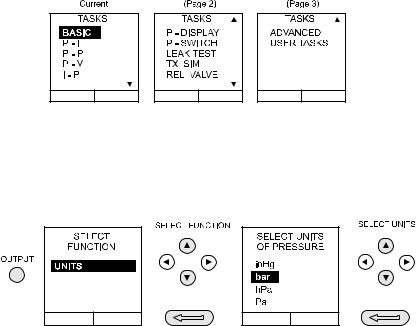
Task Selection
Task Key
The TASK key is used to set-up the instrument for a number of specific types of test. There are two modes BASIC and ADVANCED and nine other specific types of test which automatically configure the instrument on selection from the TASK menu. The tasks available under the TASK menu are held on three pages shown below. To select a task from the menu, press the TASK key, position the cursor over the required task and press the ENTER key as shown below. Use the right/left cursor keys to switch between pages.
Using TASK Functions
Specific tasks are selected as shown above. The following diagrams show how to connect the unit under test (UUT) for each task selectable under the TASK menu.
Input and output units, where applicable, can be selected by pressing either the INPUT or OUTPUT keys as shown below.
Set Units
Note: If the four units displayed are not the units required, press SETUP, select SETTINGS and refer to select regular units on page 37.
K0430 Issue No. 2 |
10 |

Task Selection
Cal Mode (DPI 615 versions only)
Cal mode, which is available in tasks P-I, P-P, P-V, P-P, P-DISPLAY and P-SWITCH, provides a method of setting up test parameters manually. Downloaded test procedures can also automatically set up and turn on the Cal Mode function. The method of turning on and setting up Cal Mode is shown below for a P-I task. A similar method can be used for all the other tasks applicable to the Cal Mode function.
|
.......... |
|
|
|
|
|
|
.......... |
TASK : P-I |
24V OFF |
|
P |
I |
|
|
TASK : P-I |
24V OFF |
|
|
SELECT VALUE |
DATALOG |
|||||
DATALOG |
|
psi |
mA |
|
||||
|
|
|
||||||
|
|
0.00 |
= |
|
4.00 |
|
|
|
|
mA |
2000.00 |
= |
|
20.00 |
|
|
mA |
|
|
|
|
|
|
|
||
|
OUTPUT |
= |
|
LINEAR |
|
. |
%span FAIL |
|
|
|
|
|
|||||
|
|
|
|
|
|
|
||
|
|
MAX. ERROR = |
|
0.05% |
|
|
|
|
|
|
ERROR TYPE = |
|
% span |
|
|
|
|
|
psi |
|
|
|
|
|
|
psi |
|
|
|
|
|
|
|
|
|
|
TURN ON |
|
|
CHANGE |
|
|
|
TURN OFF |
|
CAL MODE |
|
|
VALUE |
|
|
|
CAL MODE |
Pressing the F1 key (TURN ON CAL MODE), provides the set-up screen for the CAL mode. Initially, the cursor is placed in the UUT SPAN field to allow the required span range to be entered. The corresponding values for the UUT output parameter (current) are then set, followed by the maximum error value and error type (%rdg or % span). When all test parameters have been set-up, the screen changes to display the input and output and the test results. The test result can only be displayed to within a range of ±9.99%. If the test result is outside this range, either the left pointing (-ve error) or right pointing (+ve error) chevrons are displayed. Within this error band, the actual tolerance value is displayed. Test results can either be stored as snapshots or logged as data log files, depending on how the instrument has been set-up.
Basic Mode (Task BASIC)
This instrument will power-up in this mode the first time that it is used. To select BASIC from any other task, press the TASK key and select BASIC and press the ENTER key. BASIC mode is fully described in the Getting Started, section (see page 7).
11 |
K0430 Issue No. 2 |
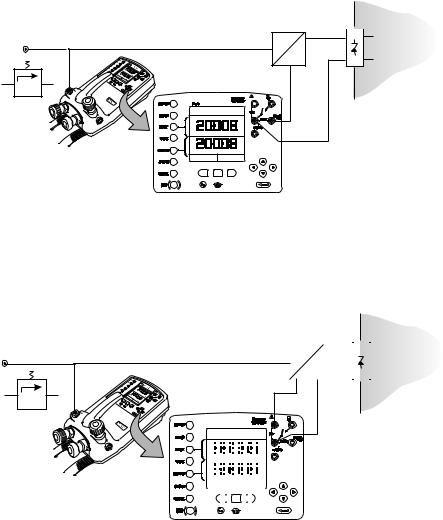
Taking Measurements
Pressure Transmitter (P-I) Task
Select the P-I task from the task menu and connect the Unit Under Test (UUT) to the calibrator as shown below:
|
|
|
|
D |
|
|
C |
|
F |
|
|
|
+ |
|
|
|
|
+ |
|
|
|
|
|
|
|
|
P |
|
E |
A |
|
|
|
|
|
I |
- |
|
|
|
|
- |
||
|
|
|
|
|
|
|
Max 30V |
|
|
|
DPI 615 IS |
CAT II |
|
|
|
|
|
D |
|
B |
TASK : P-I |
|
|
|
|
|
|
||
|
SNAPSHOT MODE |
|
|
|
|
CURRENT |
mA |
|
|
|
PRESSURE INT |
bar |
|
|
|
F1 EXIT |
F2 |
|
|
A - External pressure source (indicator instruments only) B - Pressure regulator C - Pressure to current device D - Barrier E - External supply F - Safe Area
•If required, select the output units as described on page 10.
•If applicable, turn on Cal Mode and set-up test parameters as detailed on page 11.
Voltage Output Pressure Transmitter (P-V) Task
Select the P-V task from the task menu and connect the Unit Under Test (UUT) to the instrument as shown below:
D
C F
A
B
DPI 615 IS
P |
+ |
|
|
|
|
+ |
|
|
|
|
|
||
|
|
|
|
|
E |
|
|
|
|
|
|
||
|
|
|
|
|
|
|
V |
- |
|
|
|
|
|
|
|
|
|
|
- |
|
+-
D
Max 30V
CAT II
TASK: BASIC
|
|
|
|
|
|
|
|
|
|
|
VOLTAGE |
|
V |
||||||||
|
|
|
|
|
|
|
|
|
|
|
PRESSURE INT |
|
bar |
||||||||
CURRENT |
|
PRESSURE |
||||||||
|
|
|
|
|
|
|
|
|
UNITS |
|
|
|
|
|
|
|
|
|
|
|
|
|
|
|
F1 |
|
|
EXIT |
|
F2 |
||
|
|
|
|
|
|
|
|
|
|
|
A - External pressure source (indicator instruments only) B - Pressure regulator C - Pressure to voltage device D - Barrier E - External supply F - Safe Area
•If required, select the output units as described on page 10.
•If applicable, turn on Cal Mode and set-up test parameters as detailed on page 11.
K0430 Issue No. 2 |
12 |
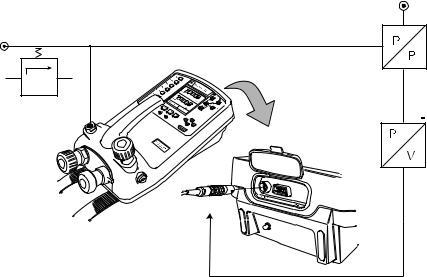
Taking Measurements
Pressure Converter (Pressure to Pressure) Task
Select the P-P task from the task menu and connect the Unit Under Test (UUT) to the calibrator as shown below. Testing a converter requires one pressure to be applied to the unit under test (UUT) and another (converter output) to be measured. The additional measurement is provided by the external transducer option.
Method
•Connect the UUT to the instrument as shown below. Plug the external transducer into the instrument as shown below:
C
A
D
 3
3
B
E
USE RS232
IN SAFE
AREA ONLY
A - External pressure source (indicator instruments only) |
B - Pressure regulator |
|
C - External pressure source |
D - Pressure to pressure device E - External transducer |
|
•Press the TASK key and select the P-P task. Providing the external transducer has been calibrated and its parameters stored in the instrument, the display will show External pressure in the input window and calibrator Output pressure in the output window. If an error message “NO SENSOR OR CAL INVALID” is displayed, this indicates that the external transducer has not been entered and/ or calibrated with the instrument. Refer to page 56 for details of adding an external transducer. If an external transducer change is made, switch the calibrator off and then on to load new transducer data.
•If required, select the input and output units as described on page 10.
•If applicable, turn on Cal Mode and set-up test parameters as detailed on page 11.
13 |
K0430 Issue No. 2 |
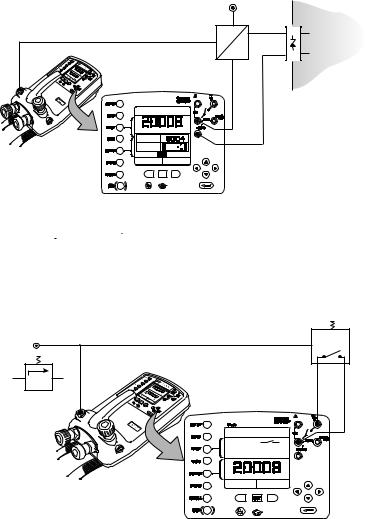
Taking Measurements
Current to Pressure Converter (I-P) Task
|
|
|
|
|
C |
|
|
|
A |
|
|
|
|
|
|
|
D |
|
|
|
|
- |
- |
|
|
|
P |
|
E |
|
|
|
I |
|
|
|
|
|
+ |
+ |
|
|
|
|
|
||
|
|
|
B - |
|
|
|
DPI 615 IS |
Max 30V |
|
C |
|
|
CAT II |
|
|||
|
|
|
|
||
|
TASK : I-P |
|
|
|
|
|
SNAPSHOT MODE |
|
|
|
|
|
PRESSURE INT |
|
bar |
|
|
|
OUTPUT |
|
|
|
|
|
NEW VALUE |
|
|
|
|
|
CURRENT |
OK |
mA |
|
|
|
F1 |
EXIT |
F2 |
|
|
A - External pressure source |
B - Pressure to current device (24V) |
|
C - Barrier |
||
D - Safe area |
E - External supply |
|
|
||
•Use the up  and down
and down  cursor keys to adjust the loop current to the required value. Alternatively, press ENTER and use cursor keys to enter a finite value. Cursor keys can then be used to nudge the output either up or down.
cursor keys to adjust the loop current to the required value. Alternatively, press ENTER and use cursor keys to enter a finite value. Cursor keys can then be used to nudge the output either up or down.
If required, change pressure units with INPUT key. A flashing CHECK LOOP message indicates either an open circuit supply loop (or no external supply).
Pressure Switch Test (P-SWITCH) Task
|
|
|
C |
A |
|
|
|
B |
|
|
|
|
|
|
max 30V |
|
|
DPI 615 IS |
|
|
|
TASK : P-SWITCH |
|
|
|
SNAPSHOT MODE |
|
|
|
CONTACT STATE |
|
|
|
PRESSURE INT |
bar |
|
|
RUN |
|
|
|
F1 |
F2 |
A - External pressure source |
B - Pressure regulator |
C - Pressure switch under test |
|
•Contact state will be shown on display. When contacts close, buzzer sounds.
•To run switch test, close vent valve and press the RUN (F1) key.
•Using the hand-pump, increase the applied pressure to just below the switch operating point. Screw the volume adjuster in until the switch operates (the operating pressure of the switch is then written to the display).
•Reduce pressure until the switch releases (indicated by the switch symbol). The release pressure is then written to the display and the hysteresis displayed.
K0430 Issue No. 2 |
14 |
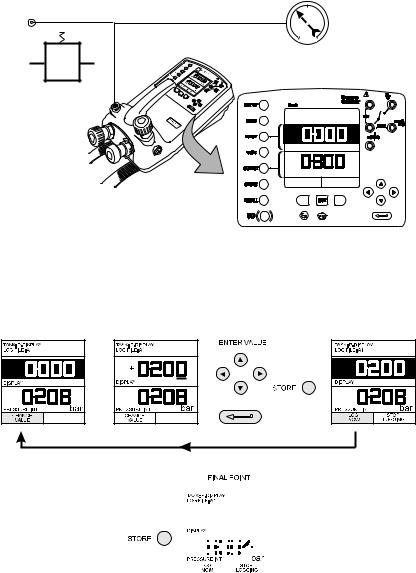
Taking Measurements
Pressure to Display (P-DISPLAY) Task
P-Display is a special application of Data Log. To use this mode, select Data Log from the Store Mode menu as detailed on page 36. Connect the UUT to the instrument as shown below and, if required, turn on and set-up Cal Mode (see page 11).
A
B |
C |
|
|
max 30V |
DPI 615 IS |
|
TASK : P-DISPLAY |
|
SNAPSHOT MODE |
|
DISPLAY |
|
PRESSURE INT |
bar |
CHANGE |
|
VALUE |
|
F1 |
F2 |
A - External pressure source |
B - Pressure regulator C - Dial gauge under test |
•Press TASK and select P-DISPLAY. If required, use OUTPUT key to change pressure units.
•Set-up a data log file as detailed on page 30.
Note: TRIGGER field, automatically set to KEYPRESS, cannot be changed.
•Apply a series of test pressures to the device under test. Enter displayed reading at each pressure and log each point:
•After logging final test point, terminate as follows:
|
|
|
|
|
|
|
|
|
|
|
|
|
|
|
|
|
|
|
|
|
|
|
|
|
|
|
|
|
|
|
|
|
|
|
|
|
|
|
|
|
|
|
|
|
|
|
|
|
|
|
|
|
|
|
|
15 |
|
|
|
|
K0430 Issue No. 2 |
|

Taking Measurements
Leak Test (LEAK TEST) Task
A
C
B
max 30V
DPI 615 IS
TASK : LEAK TEST
SNAPSHOT MODE
PRESSURE INT |
|
bar |
WAIT |
60 |
secs |
DURATION |
60 |
secs |
START PRESS |
|
bar |
STOP PRESS |
|
bar |
PRESS CHANGE |
|
bar |
LEAK RATE |
|
bar/m |
CHANGE |
|
RUN |
VALUE |
|
|
F1 |
|
F2 |
A - External pressure source B - Pressure regulator C - Device/system under test
•If required, use the INPUT key to change pressure units.
•Set-up the leak test WAIT and DURATION times to the required values as shown below. A minimum wait period of 3 minutes is recommended.
•Close the vent valve and pressurize the device/system to the required LEAK TEST pressure.
•Press the RUN (F2) key to start the leak test. When completed, the beeper sounds and the leak test results are written to the display.
K0430 Issue No. 2 |
16 |
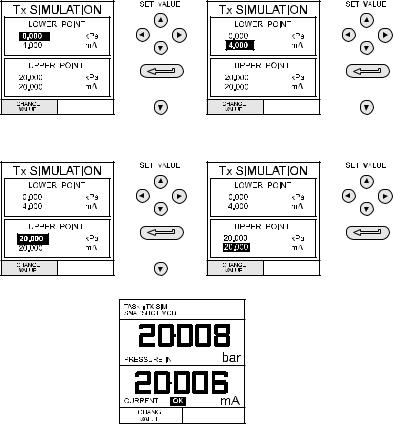
Taking Measurements
Transmitter Simulator (TX SIM) Task
When used with an external voltage source (see page 24), provides a current output proportional to the calibrator’s measured output pressure (indicated pressure on indicator only version). Select task TX SIM. Press EXIT to skip set-up screen if parameters are correct.
On completion of Tx SIM set-up, the display is configured as follows :.
Connect an external power source to the output loop as detailed on page 24.
To subsequently change any of the Tx SIM scaling parameters, press CHANGE VALUE key (F1) to obtain the TX Simulation set-up display.
To change the pressure units, press INPUT and select the required scale units. If the required scale units are not listed, press SETUP, select SETTINGS and proceed as detailed on page 37.
17 |
K0430 Issue No. 2 |
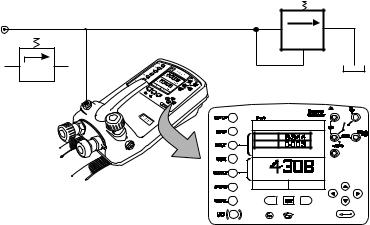
Taking Measurements
Relief Valve Test (REL VALVE) Task
To carry out a relief valve test, press TASK and select REL VALVE. Connect the output pressure port of the instrument to an external system as shown below:
A C
B
max 30V
DPI 615 IS
TASK : RELVALVE
SNAPSHOT MODE
MAXIMUM
MINIMUM
PRESSURE INT |
bar |
PRESSURE INT |
bar |
RESET |
|
MAX/MIN |
|
F1 |
F2 |
A - External pressure source (indicator only) B - Pressure regulator C - Relief valve under test
•To change the pressure units, if required, press INPUT and select the required units using the cursor keys.
•Close the vent valve and, using the hand-pump or external pressure supply, apply pressure to the relief valve under test.
•When the relief valve operates, the maximum recorded pressure indicates the operating point of the valve.
•Record the test results.
Note: The STORE key can be used for this purpose. Use right cursor key initially, followed by up/down keys to enter Snapshot text.
•Open vent valve to release test pressure.
Note: If using external pressure supply, isolate supply before opening the vent valve.
K0430 Issue No. 2 |
18 |
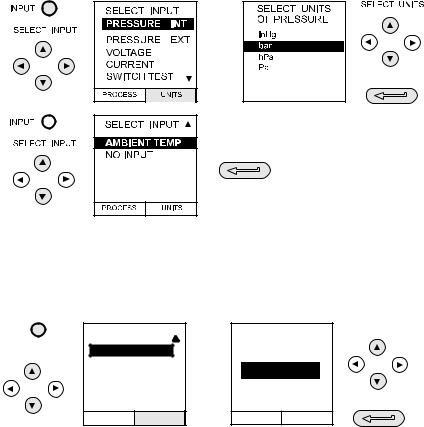
Advanced Task |
Select Input |
General
Advanced task allows the user to configure the instrument to monitor one of a number of different input measurements and outputs (sources). Additionally, five process functions, Tare, Max/Min, Filter, Flow and % Span can be applied to the input functions.
Select Input
To select an input channel, select ADVANCED task from the task menu. The display shows the list of the input selections and, if available, the PROCESS soft box (F1) and the UNITS soft box (F2).
The following procedure shows the method of input channel selection and the method of changing units:
Note: Left/right arrow keys function as page up/down keys.
Refer to pages 20 to 23 for details of process functions.
Ambient Temperature Measurement
To set-up the instrument to read ambient temperature, proceed as follows:
INPUT |
SELECT INPUT |
SELECT AIR |
SELECT UNITS |
|
|||
|
TEMPERATURE |
|
|
|
|
|
|
SELECT INPUT |
AMBIENT TEMP |
UNITS |
|
|
NO INPUT |
CELSIUS |
|
|
|
|
|
|
|
FAHRENHEIT |
|
PROCESS UNITS
Note: Ensure that the temperature reading has stabilised.
19 |
K0430 Issue No. 2 |
